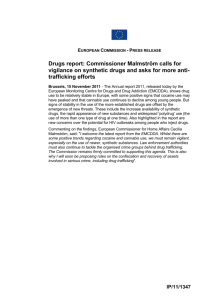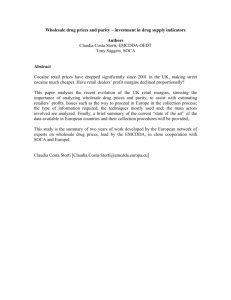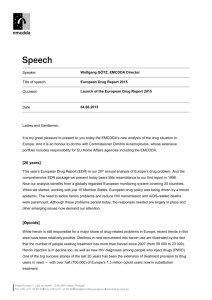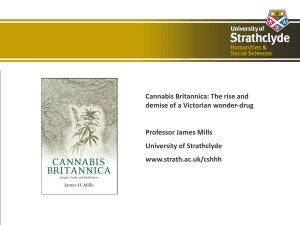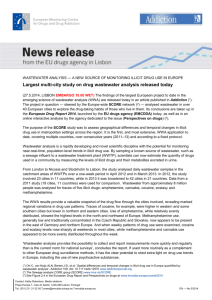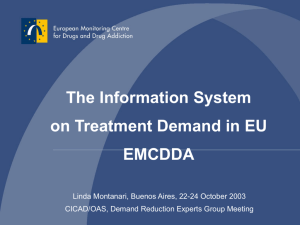News release EN - EMCDDA
advertisement
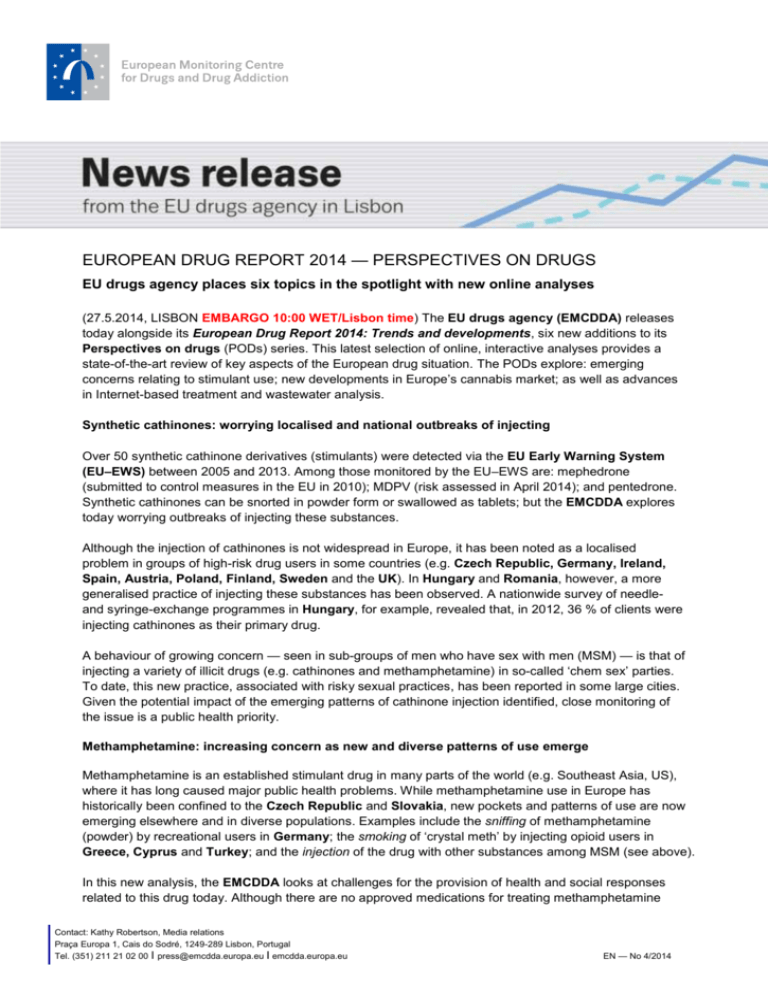
EUROPEAN DRUG REPORT 2014 — PERSPECTIVES ON DRUGS EU drugs agency places six topics in the spotlight with new online analyses (27.5.2014, LISBON EMBARGO 10:00 WET/Lisbon time) The EU drugs agency (EMCDDA) releases today alongside its European Drug Report 2014: Trends and developments, six new additions to its Perspectives on drugs (PODs) series. This latest selection of online, interactive analyses provides a state-of-the-art review of key aspects of the European drug situation. The PODs explore: emerging concerns relating to stimulant use; new developments in Europe’s cannabis market; as well as advances in Internet-based treatment and wastewater analysis. Synthetic cathinones: worrying localised and national outbreaks of injecting Over 50 synthetic cathinone derivatives (stimulants) were detected via the EU Early Warning System (EU–EWS) between 2005 and 2013. Among those monitored by the EU–EWS are: mephedrone (submitted to control measures in the EU in 2010); MDPV (risk assessed in April 2014); and pentedrone. Synthetic cathinones can be snorted in powder form or swallowed as tablets; but the EMCDDA explores today worrying outbreaks of injecting these substances. Although the injection of cathinones is not widespread in Europe, it has been noted as a localised problem in groups of high-risk drug users in some countries (e.g. Czech Republic, Germany, Ireland, Spain, Austria, Poland, Finland, Sweden and the UK). In Hungary and Romania, however, a more generalised practice of injecting these substances has been observed. A nationwide survey of needleand syringe-exchange programmes in Hungary, for example, revealed that, in 2012, 36 % of clients were injecting cathinones as their primary drug. A behaviour of growing concern — seen in sub-groups of men who have sex with men (MSM) — is that of injecting a variety of illicit drugs (e.g. cathinones and methamphetamine) in so-called ‘chem sex’ parties. To date, this new practice, associated with risky sexual practices, has been reported in some large cities. Given the potential impact of the emerging patterns of cathinone injection identified, close monitoring of the issue is a public health priority. Methamphetamine: increasing concern as new and diverse patterns of use emerge Methamphetamine is an established stimulant drug in many parts of the world (e.g. Southeast Asia, US), where it has long caused major public health problems. While methamphetamine use in Europe has historically been confined to the Czech Republic and Slovakia, new pockets and patterns of use are now emerging elsewhere and in diverse populations. Examples include the sniffing of methamphetamine (powder) by recreational users in Germany; the smoking of ‘crystal meth’ by injecting opioid users in Greece, Cyprus and Turkey; and the injection of the drug with other substances among MSM (see above). In this new analysis, the EMCDDA looks at challenges for the provision of health and social responses related to this drug today. Although there are no approved medications for treating methamphetamine Contact: Kathy Robertson, Media relations Praça Europa 1, Cais do Sodré, 1249-289 Lisbon, Portugal Tel. (351) 211 21 02 00 I press@emcdda.europa.eu I emcdda.europa.eu EN — No 4/2014 Perspectives on drugs I EMBARGO 10:00 WET/Lisbon time 27.5.2014 dependence, psychosocial interventions have proven effective. The agency says: ‘Europe’s current methamphetamine problem has no single face and appropriate responses will need to be adapted, developed and tailored to the local patterns of use and problems observed’. Reviewing progress with medications to treat cocaine dependence Cocaine is still Europe’s most commonly used illicit stimulant and challenges remain in treating cocaine dependence. In 2012, 14 % of clients entering specialist drug treatment in Europe reported cocaine as their primary substance. The EMCDDA presents today a meta-analysis of six reviews examining the effectiveness of medications used in treating cocaine problems, as well as their acceptance by users. The original reviews, by the Cochrane Drugs and Alcohol Group, involved 92 studies (85 in the US) and over 7 000 participants. These show how some medications can reduce users’ cravings, yet no single pharmacological solution has been found for cocaine dependence. As research in this area progresses, psychosocial interventions remain a core element in treating cocaine users (see video). Domestic herbal cannabis production, a major supply source — imported resin getting stronger Europe has long been one of the world’s largest consumer markets for cannabis, particularly resin imported mainly from Morocco. Some 2 050 tonnes of cannabis resin (‘hashish’) and herbal cannabis (‘marijuana’) are estimated to be consumed in Europe every year. Today, the EMCDDA reports how Europe’s consumer market for cannabis is now dominated by herbal products, with domestic herbal production supplying domestic use. Cannabis plantations are increasingly found across Europe. Over the last decade, the number of seizures of herbal cannabis in Europe has overtaken that of resin. Some 457 000 herbal cannabis seizures were reported in 2012, compared with 258 000 resin seizures. Around seven million cannabis plants were seized in 2012, over 2.5 times the quantity reported five years earlier. Innovations in cannabis production in recent years are cause for concern (see video), with growers cultivating plants high in THC (the active ingredient in cannabis) but low in CBD (an antipsychotic). While the potency of both forms of cannabis has risen since 2006, relatively sharp rises in the potency of resin have been seen between 2011 and 2012 (see cannabis infographic, EDR, Chapter 1). Internet-based drug treatment — offering new ways of engaging with drug users The Internet is now recognised as a plausible vehicle for delivering drug and alcohol education, prevention and treatment programmes in a range of settings. Today, the EMCDDA charts developments in Internet-based drug treatment (IBDT), which has expanded in Europe over the past 10 years, mainly relating to cannabis use. IBDT takes a set of tested psychosocial techniques and integrates them into a new web-based delivery mechanism. Although data protection and anonymity are important issues to address, the benefits gained from this type of service delivery can include: greater geographical coverage; access to users not reached by specialist drug services; and more immediate assistance (no waiting times). As IBDT programmes develop, they may form a useful complement to traditional treatment services, offering new ways of engaging with drug users in need of help (see video). Largest multi-city study on drug wastewater analysis released today The findings of the largest European project to date in the emerging science of wastewater analysis are also released today. The project in question analysed wastewater in over 40 cities (21 countries) to explore the drug-taking habits of those who live in them. Its conclusions are taken up in an EMCDDA POD dedicated to the issue. Wastewater from approximately 8 million people was analysed for traces of five illicit drugs: amphetamine, cannabis, cocaine, ecstasy and methamphetamine (news release 5/2014). The results provide a valuable snapshot of the drug flow through the cities involved, revealing marked regional variations in drug use patterns. Traces of cocaine, for example, were higher in western and some southern cities but lower in northern and eastern cities. Use of amphetamine, while relatively evenly distributed, showed the highest levels in the north and northwest of Europe. Methamphetamine use, generally low and traditionally concentrated in Central Europe, now appears to be spreading. And when Perspectives on drugs (PODs) — available in English at www.emcdda.europa.eu/edr2014 Perspectives on drugs I EMBARGO 10:00 WET/Lisbon time 27.5.2014 weekly patterns of drug use were examined, cocaine and ecstasy levels rose sharply at weekends in most cities, while methamphetamine and cannabis use appeared to be more evenly distributed throughout the week. Chairman of the EMCDDA Management Board, João Goulão says: ‘This year, the EMCDDA highlights an array of new challenges posed by stimulants and other drugs. In particular, the agency explores the emerging and growing evidence base for treating problems related to cocaine, methamphetamine and cannabis use. A common element here is the importance of psychosocial interventions which represent a valuable part of our therapeutic toolbox for responding to contemporary drug problems’. Perspectives on drugs (PODs) — available in English at www.emcdda.europa.eu/edr2014
